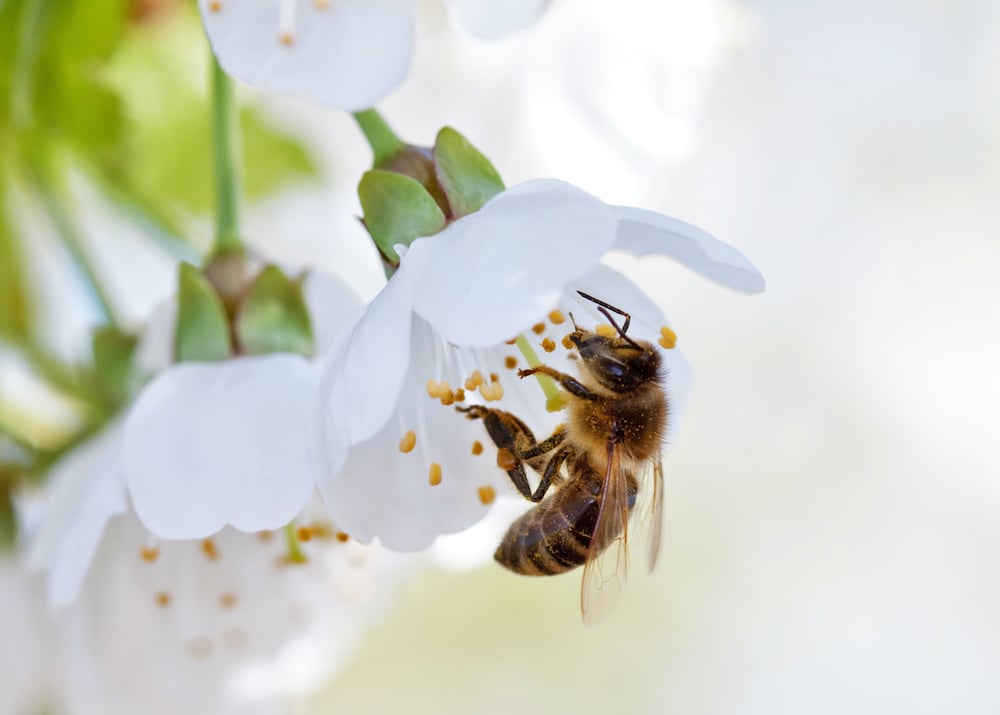10 Home Remedies for Bee Stings & Wasp Stings
Bee and wasp season can present a problem for people who are allergic to wasp stings. The good news is – most people respond very well to home remedies for bee stings.
I once had the misfortune of sharing a donut with a bee. I was at a summer parade and all I can remember is sugar, crunchy wings, and PAIN.

No one had any baking soda on hand, but someone’s mom said that tobacco would take the swelling down, so she opened a cigarette and told me to use the insides of it as a compress. Needless to say… that’s not on our list of natural remedies for kids!
But here are 10 ways to relieve the pain from bee and wasp stings naturally.
You will probably see the bee’s stinger as a tiny black dot in the center of a red welt or swollen area. Depending on how long the stinger has been lodged into the skin, it could still be twitching and festering (and stinging – ouch!).
If you’re not allergic, you might only notice the pain of the sting and the swelling or itching afterward. If you don’t know whether you are (or your child is) allergic, here are the most common bee sting allergy symptoms
- hives
- redness
- swelling in places not close to the sting location
With an anaphylactic reaction, the person might experience wheezing, difficulty breathing, or a drop in blood pressure that can lead to shock if not treated promptly.
Home Remedies for Bee Stings (and Wasps)
Here are ten of the most popular home remedies to keep in your natural first aid kit just in case you have a run-in with one of our winged friends this summer.
Get the Stinger Out First
The first step is to remove the stinger with a pair of tweezers. If no tweezers are available, take a stiff card (like a credit/debit card) and firmly slide the edge over the bee sting.
Always avoid pressing the stinger deeper into the skin, as this can increase the chances of pain or an allergic response.
Wash the sting site with soap and water. Icing a bee sting helps reduce venom absorption and can reduce swelling. Witch hazel is great to swipe across insect stings to clean and soothe the area. Then try one of these bee sting natural remedies.
1. Baking soda
Make a thick paste of water and baking soda. Apply it directly to the sting and let it dry. The alkaline properties of the baking soda reduce the swelling and irritation.
2. Apple cider vinegar
I really haven’t found too many things ACV doesn’t help with. Pour a little bee sting vinegar straight from the bottle onto the affected area. The acidity in the apple cider vinegar can help neutralize the toxins and ease the swelling and pain.
Make sure you keep raw apple cider vinegar in your pantry. It’s much more effective than the processed vinegar.
3. Raw honey
Honey is one of the crazier home remedies for bee stings, but it’s been used for centuries for just that. Raw honey is loaded with antibacterial, antimicrobial, and anti-inflammatory properties. Leave it on for at least 30 minutes before you wash it off. Repeat as needed.
4. Basil
I love basil and always plant it in my kitchen herb garden. Not only great for seasoning food, it has anti-inflammatory properties that make it great for taking the swelling and irritation out of a bee sting.
Take a handful of basil leaves and crush them up until you get a paste. Place the paste directly on the sting. Leave it on there for about 30 minutes before you rinse, gently, with warm water. Repeat as needed.
5. Calendula
Calendula is one plant every garden should have. It not only produces beautiful bright flowers but it’s loaded with anti-inflammatory, antibacterial, anti-fungal, and antiseptic properties. I keep calendula salve handy all the time but if you don’t have some on hand, you can make a calendula compress to apply directly to the sting.
Just pick some of your calendula flowers (at least a good handful) and place them in a pan with filtered water. Bring the water to boil and let it simmer for about 15 minutes. Allow it to cool, soak a clean cloth in the water, and apply it directly to the sting. Repeat 3 or 4 times a day as needed.
You can also buy a gentle calendula cream or gel to keep on hand to help with a variety of ailments and skin irritations.
6. Onion
Lesser known home remedies for bee stings, onions contain enzymes that draw out fluids and help relieve the swelling and irritation of the sting. Just take a slice of fresh onion and apply it directly to the sting and hold it there for a few minutes. Repeat as needed.
7. Papaya
Papaya contains “papain”, an enzyme that helps with digestion, helps break down the venom in bee stings and has antiseptic properties. It’s great for applying directly to stings and burns and other skin wounds. Just mash a slice of papaya and apply it as a paste to the sting. Or you can just hold the slice of papaya on the sting.
8. Plantain leaf
Not the tiny bananas, but the “weed” that grows just about anywhere. The tannins in the plantain leaves are great for wounds and are famous for stopping bleeding. This is a really quick treatment for bee stings because all you have to do is pick a plantain leaf from your yard (unless you are using chemical pesticides), chew it up and make a paste, and apply it directly to the bee sting.
9. Lavender essential oil
If you are only going to invest in one essential oil, get a good bottle of pure organic lavender essential oil. It has enough uses to post on every day for a year and not cover them all.
Lavender essential oil has properties that will neutralize the venom, reduce the swelling, relieve the pain and help to calm the person who was stung. You can apply it directly to the sting without diluting it, just one drop should be plenty, and you can apply it as needed.
10. Turmeric
Turmeric has been used in India for centuries to not only season food but for its anti-inflammatory, antiseptic, and antibacterial properties. You can buy organic dried turmeric powder online or in the spice aisle and keep it on hand.
Make a paste from turmeric powder and filtered water (a thick paste, not runny) and apply it to the sting. Let it stay on there for about 30 minutes, then rinse gently with warm water. You can reapply it as needed every 3 or 4 hours.
How Long Does a Bee Sting Last?
A bee sting can last as long as the stinger remains buried in the skin. It’s always best to remove it immediately and apply a home remedy to ease the pain and swelling.
After you remove the stinger, apply one of these home remedies for bee stings for almost immediate relief. These remedies can be used by people with a normal reaction to stings, not a medical emergency.
Even though they can be dangerous to some people, it’s better to try to avoid bees than kill them. Our ecosystem and food supply depend on them. You’re less likely to get stung if you calmly avoid the honey bee.
Now that you’re armed with a good list of home remedies for bee stings, don’t let the little winged bees and wasps keep you inside. Find plenty of ideas for outdoor fun with kids here.


